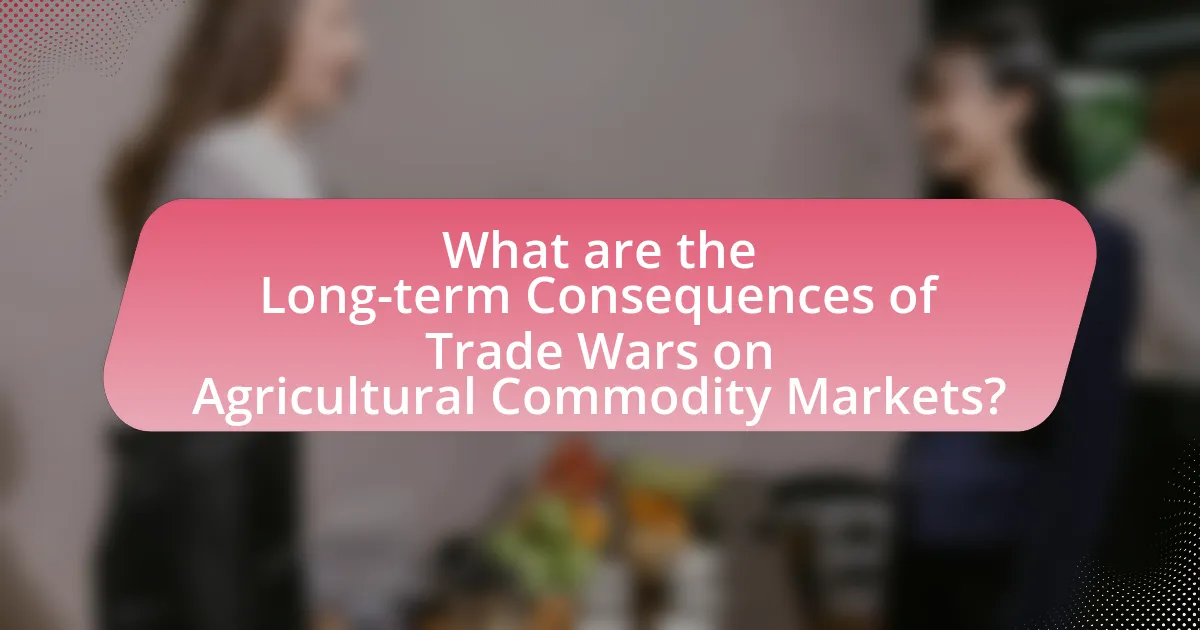Trade wars are economic conflicts characterized by the imposition of tariffs and trade barriers between countries, significantly impacting agricultural commodity markets. This article examines the initiation and escalation of trade wars, key factors that trigger them, and government responses to trade disputes. It highlights the importance of agricultural commodities in these conflicts, detailing how tariffs affect prices, supply and demand dynamics, and the livelihoods of farmers. Additionally, the article explores the long-term consequences of trade wars on global agricultural trade patterns, food security, and the broader economic implications, while offering best practices for stakeholders to navigate these challenges effectively.

What are Trade Wars and Their Relevance to Agricultural Commodity Markets?
Trade wars are economic conflicts that arise when countries impose tariffs or other trade barriers on each other to protect domestic industries. These conflicts significantly impact agricultural commodity markets by altering supply chains, affecting prices, and influencing trade volumes. For instance, the U.S.-China trade war initiated in 2018 led to China imposing tariffs on U.S. agricultural products, resulting in a 50% drop in U.S. soybean exports to China by 2019. This disruption caused volatility in global agricultural prices and forced U.S. farmers to seek alternative markets, demonstrating the direct relevance of trade wars to agricultural commodity markets.
How do trade wars initiate and escalate?
Trade wars initiate when countries impose tariffs or trade barriers in response to perceived unfair trade practices, such as dumping or currency manipulation. For example, the U.S.-China trade war began in 2018 when the U.S. imposed tariffs on Chinese goods, citing intellectual property theft and trade imbalances. Escalation occurs as countries retaliate with their own tariffs, leading to a cycle of increasing trade barriers. This was evident when China responded to U.S. tariffs with its own, affecting billions in trade and impacting global markets. The escalation can further intensify as nations engage in negotiations, which may fail, prompting additional tariffs and broader economic consequences.
What are the key factors that trigger trade wars?
Key factors that trigger trade wars include economic imbalances, protectionist policies, and political tensions. Economic imbalances arise when one country perceives another as benefiting disproportionately from trade, leading to calls for tariffs or trade barriers. Protectionist policies, such as tariffs and quotas, are implemented to shield domestic industries from foreign competition, often escalating into retaliatory measures. Political tensions, including national security concerns or diplomatic disputes, can also provoke trade wars, as countries leverage trade as a tool for political leverage. Historical examples, such as the U.S.-China trade war initiated in 2018, illustrate how these factors can converge, resulting in significant tariffs and trade restrictions that impact global markets, including agricultural commodities.
How do governments respond to trade disputes?
Governments respond to trade disputes primarily through diplomatic negotiations, legal actions, and the imposition of tariffs or trade barriers. For instance, when the United States and China engaged in a trade dispute, both countries utilized the World Trade Organization (WTO) to address grievances, while also implementing tariffs on each other’s goods, which significantly impacted agricultural commodity markets. According to the U.S. Department of Agriculture, the tariffs led to a decline in U.S. agricultural exports to China, illustrating how government actions directly affect trade dynamics and market stability.
What is the significance of agricultural commodities in trade wars?
Agricultural commodities play a crucial role in trade wars as they are often used as leverage in negotiations and retaliatory measures. For instance, during the U.S.-China trade war, China imposed tariffs on American agricultural products like soybeans and pork, significantly impacting U.S. farmers and the agricultural economy. This strategic targeting of agricultural commodities highlights their importance in trade relations, as they can influence domestic markets and political sentiments. The U.S. Department of Agriculture reported that the tariffs led to a decline in U.S. soybean exports to China by over 70% in 2018, demonstrating the direct economic consequences of using agricultural commodities in trade disputes.
Why are agricultural products often targeted in trade conflicts?
Agricultural products are often targeted in trade conflicts because they are essential commodities that significantly impact national economies and food security. Countries frequently use tariffs and trade barriers on agricultural goods to protect domestic farmers and influence trade balances. For instance, during the U.S.-China trade war, both nations imposed tariffs on each other’s agricultural exports, such as soybeans and pork, to exert economic pressure and negotiate better trade terms. This targeting is further driven by the political significance of agriculture in rural economies, where farmers can be a crucial voting bloc.
How do agricultural commodities impact national economies during trade wars?
Agricultural commodities significantly impact national economies during trade wars by influencing trade balances, domestic prices, and food security. When countries impose tariffs on agricultural products, it can lead to reduced exports for the affected nations, negatively impacting their agricultural sectors and overall economic performance. For instance, during the U.S.-China trade war, U.S. soybean exports to China dropped by 74% in 2018, leading to a loss of approximately $1.3 billion for American farmers. This decline not only affected farmers’ incomes but also had ripple effects on related industries, such as transportation and processing, thereby straining the broader economy. Additionally, trade wars can lead to increased domestic prices for agricultural goods, which can exacerbate food insecurity and inflation, further destabilizing national economies.

What are the Immediate Effects of Trade Wars on Agricultural Commodity Markets?
The immediate effects of trade wars on agricultural commodity markets include price volatility, reduced export demand, and increased production costs. For instance, when tariffs are imposed, agricultural products often face higher prices in foreign markets, leading to a decline in demand; the U.S.-China trade war resulted in a 50% drop in U.S. soybean exports to China in 2018. Additionally, farmers may experience increased costs for imported inputs, such as fertilizers and machinery, due to retaliatory tariffs, which can further strain profit margins. These dynamics create uncertainty in agricultural markets, affecting both producers and consumers.
How do tariffs influence agricultural commodity prices?
Tariffs increase agricultural commodity prices by raising the cost of imported goods, which can lead to higher prices for domestic products. When a government imposes tariffs on agricultural imports, it makes foreign products more expensive, reducing competition for local farmers. For instance, the U.S.-China trade war resulted in tariffs on soybeans, causing U.S. soybean prices to rise by approximately 20% in 2018 due to decreased supply from China, which had previously been a major importer. This price increase reflects the direct impact of tariffs on market dynamics, as domestic producers can charge more when foreign competition is limited.
What are the short-term price fluctuations observed during trade wars?
Short-term price fluctuations during trade wars often manifest as increased volatility in agricultural commodity markets. For instance, when the United States imposed tariffs on Chinese goods in 2018, prices for soybeans dropped significantly, falling by approximately 20% within months due to reduced demand from China, a major importer. Conversely, prices for commodities like corn and wheat may experience temporary spikes as traders react to supply chain disruptions and shifts in trade patterns. Historical data from the U.S. Department of Agriculture indicates that such fluctuations can lead to rapid price adjustments, reflecting market uncertainty and changing trade dynamics.
How do tariffs affect supply and demand dynamics in agriculture?
Tariffs directly influence supply and demand dynamics in agriculture by increasing the cost of imported goods, which can lead to reduced supply and higher prices for consumers. When tariffs are imposed on agricultural imports, domestic producers may face less competition, potentially increasing their market share and allowing them to raise prices. For example, the U.S.-China trade war resulted in tariffs on soybeans, leading to a significant drop in U.S. soybean exports to China, which decreased overall demand for U.S. soybeans and caused prices to fall. This illustrates how tariffs can disrupt traditional supply chains and alter market equilibrium, affecting both producers and consumers in the agricultural sector.
What are the impacts on farmers and agricultural producers?
Trade wars significantly impact farmers and agricultural producers by disrupting market access and reducing export opportunities. For instance, tariffs imposed during trade conflicts can lead to increased costs for farmers, as they may face higher prices for imported goods and equipment. Additionally, retaliatory tariffs from other countries can decrease demand for U.S. agricultural products, resulting in lower prices and reduced income for producers. According to the American Farm Bureau Federation, the trade war with China alone resulted in an estimated loss of $1.3 billion in agricultural exports in 2018. This economic strain can lead to financial instability for farmers, affecting their ability to invest in crops and maintain operations.
How do trade wars affect farmers’ income and livelihoods?
Trade wars negatively impact farmers’ income and livelihoods by disrupting export markets and increasing production costs. When tariffs are imposed, farmers face reduced access to international markets, leading to lower prices for their goods. For instance, the U.S.-China trade war resulted in a 20% drop in soybean prices, significantly affecting American soybean farmers’ earnings. Additionally, increased costs for imported materials, such as fertilizers and equipment due to tariffs, further strain farmers’ financial stability. Consequently, these factors can lead to decreased investment in farming operations and potential long-term economic hardship for agricultural communities.
What strategies do farmers adopt to cope with trade war challenges?
Farmers adopt several strategies to cope with trade war challenges, including diversifying their markets, adjusting crop production, and utilizing government assistance programs. By seeking new export markets or focusing on domestic sales, farmers mitigate the risks associated with reduced access to traditional markets. For instance, during the U.S.-China trade war, many farmers shifted their focus to alternative markets in countries like Mexico and Canada. Additionally, farmers may alter their crop choices based on market demand and profitability, which can help them remain competitive despite fluctuating trade conditions. Government assistance programs, such as the Market Facilitation Program, provide financial support to offset losses incurred due to trade disputes, further aiding farmers in navigating these challenges.

What are the Long-term Consequences of Trade Wars on Agricultural Commodity Markets?
Long-term consequences of trade wars on agricultural commodity markets include increased price volatility, reduced market access, and shifts in global supply chains. Trade wars often lead to tariffs that raise costs for producers and consumers, resulting in fluctuating prices for agricultural commodities. For instance, the U.S.-China trade war initiated in 2018 caused significant disruptions, with U.S. soybean exports to China dropping by over 70% in 2019, illustrating how tariffs can drastically alter trade flows. Additionally, prolonged trade tensions can incentivize countries to seek alternative suppliers, leading to a reconfiguration of global agricultural supply chains that may not revert even after trade disputes are resolved. This shift can result in long-lasting impacts on market dynamics and competitiveness in the agricultural sector.
How do trade wars reshape global agricultural trade patterns?
Trade wars reshape global agricultural trade patterns by altering tariffs and trade agreements, which directly impact the flow of agricultural goods between countries. For instance, when the United States imposed tariffs on Chinese imports in 2018, China responded with tariffs on U.S. agricultural products, leading to a significant decline in U.S. soybean exports to China, which dropped from 33 million metric tons in 2017 to just 14 million metric tons in 2018. This shift forced U.S. farmers to seek alternative markets, such as Brazil, which increased its soybean exports to China, demonstrating how trade wars can redirect trade flows and create new market dynamics.
What new markets emerge as a result of shifting trade relationships?
Shifting trade relationships lead to the emergence of new markets such as alternative agricultural export destinations and local sourcing initiatives. For instance, when traditional trade partners impose tariffs, countries often seek new buyers for their agricultural products, resulting in increased exports to regions like Southeast Asia or Africa. Additionally, local sourcing initiatives gain traction as businesses aim to reduce dependency on foreign imports, fostering domestic agricultural markets. This shift is evidenced by the U.S. exporting more soybeans to countries like Vietnam and the Philippines after tariffs were imposed on Chinese imports, highlighting the adaptability of agricultural markets in response to changing trade dynamics.
How do trade wars influence agricultural innovation and practices?
Trade wars significantly influence agricultural innovation and practices by altering market access and incentivizing farmers to adapt to new economic conditions. For instance, when tariffs are imposed, farmers may seek innovative methods to reduce costs or improve efficiency to remain competitive in a constrained market. A study by the USDA Economic Research Service in 2019 indicated that trade tensions led to a 20% increase in research and development investments among agricultural firms, as they aimed to develop alternative crops and technologies that could thrive under changing trade policies. Additionally, farmers may adopt new practices such as precision agriculture or sustainable farming techniques to enhance productivity and meet shifting consumer demands, driven by the need to navigate the complexities of trade restrictions.
What are the broader economic implications of trade wars on agriculture?
Trade wars have significant broader economic implications on agriculture, primarily by disrupting supply chains and altering market access. These conflicts often lead to increased tariffs on agricultural products, which can raise costs for farmers and consumers alike. For instance, the U.S.-China trade war resulted in China imposing tariffs on U.S. agricultural exports, leading to a 50% drop in U.S. soybean exports to China in 2018, according to the U.S. Department of Agriculture. This disruption not only affects farmers’ incomes but also leads to volatility in global commodity prices, impacting food security and agricultural investment. Additionally, trade wars can prompt retaliatory measures, further complicating international trade relationships and reducing overall agricultural trade volumes.
How do trade wars affect food security and prices globally?
Trade wars negatively impact food security and prices globally by disrupting supply chains and increasing costs. When countries impose tariffs on agricultural products, it raises the prices of imported goods, leading to higher consumer prices and reduced access to food. For instance, the U.S.-China trade war resulted in a 25% tariff on soybeans, which significantly affected farmers and consumers, causing soybean prices to fluctuate and impacting global food supply. Additionally, trade wars can lead to retaliatory measures, further complicating international trade and exacerbating food insecurity in vulnerable regions reliant on imports.
What role do trade agreements play in mitigating trade war impacts?
Trade agreements play a crucial role in mitigating the impacts of trade wars by establishing frameworks for tariff reductions and trade facilitation among countries. These agreements can help stabilize markets by providing predictable trade conditions, which is essential for agricultural commodity markets that are often volatile. For instance, the United States-Mexico-Canada Agreement (USMCA) replaced NAFTA and aimed to reduce trade barriers, thereby promoting agricultural exports and imports among the three nations. This predictability can help farmers and producers plan their operations more effectively, reducing the adverse effects of trade wars, such as sudden tariff increases that can disrupt supply chains and pricing. Additionally, trade agreements often include dispute resolution mechanisms that can address grievances without escalating tensions, further contributing to market stability during trade conflicts.
What best practices can stakeholders adopt to navigate trade wars effectively?
Stakeholders can navigate trade wars effectively by diversifying supply chains and markets. Diversification reduces dependency on any single market, mitigating risks associated with tariffs and trade barriers. For instance, during the U.S.-China trade war, agricultural exporters who expanded their customer base to countries like Canada and Mexico were better positioned to offset losses from reduced Chinese demand. Additionally, stakeholders should engage in proactive risk management by utilizing hedging strategies to protect against price volatility. According to the USDA, farmers who employed futures contracts during trade tensions were able to stabilize their income despite fluctuating market conditions. These practices enable stakeholders to maintain resilience and adaptability in the face of trade disruptions.















